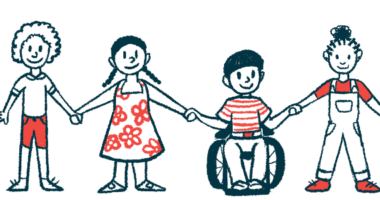Patient Draws on Her Own Experience to Help Others Through Podcast

Poravute Siriphiroon/Shutterstock
Kerry Gabrielson, a 34-year-old with Ehlers-Danlos syndrome (EDS), is devoting herself to raising awareness about hypermobile diseases and helping people with these disorders learn how to manage their symptoms through her podcast “Hypermobility Happy Hour.”
In the 34 episodes aired to date, Gabrielson has interviewed experts on topics ranging from animals with EDS, disability accommodations, and the importance of gut health. The show, available on iTunes, Spotify, SoundCloud, and Google Podcasts, has reached listeners in at least 50 countries.

The logo of Kerry Gabrielson’s podcast, “Hypermobility Happy Hour.” (Photo courtesy of Kerry Gabrielson)
As a former commercial litigator, Gabrielson is familiar with the intricate research process that goes into every case. While she knew nothing about the condition at first, she quickly set out to learn more about EDS and the latest research, but what she found didn’t seem too promising.
“There wasn’t a lot of good support or understanding even of the condition, and what was out there was just so relentlessly negative,” Gabrielson said. “Even if there weren’t a lot of answers out there about Ehlers-Danlos, we could start to have discussions and focus on what we can do to improve our condition instead of always focusing on the things that we can’t do.”
EDS, with which she was diagnosed in 2016, is not the only condition that Gabrielson has. It took until 2019 for doctors to uncover her mast cell activation syndrome, in which mast cells release certain molecules that cause abnormal allergic reactions; postural orthostatic tachycardia syndrome (POTS), which affects blood flow; and hereditary alpha tryptasemia, where elevated levels of tryptase, an enzyme released during an allergic reaction, are found in the bloodstream. Last October, Gabrielson found out she had a tethered spinal cord, where the spinal cord is attached to tissue around the spinal column, limiting its movement.
Collectively, these conditions have caused an array of symptoms she must manage and eventually made it impossible for her to do her job as an attorney. Because her connective tissues don’t have the same integrity as the average person, she experiences frequent musculoskeletal pain and has needed about a dozen surgeries to fix frequent connective tissue damage.
With her POTS diagnosis, changes in temperature, her posture, or position can cause her to feel lightheaded. Because of her increased sensitivity to histamines, anything from bug bites to blooming trees to certain types of foods can cause severe nausea, digestive problems, headaches, and fatigue.
She’s only recently gotten to the bottom of things that had seemed abnormal, like her long toes and fingers that bend at the last joint, and losing vision after running down the stairs as a child. However, it took decades to get answers, involving research and help from friends who were in residency as doctors and could direct Gabrielson to the correct medical specialists.
The lack of answers and long journey to diagnosis inspired her to start “Hypermobility Happy Hour” and help others, who might not have access to the same resources she did, get to a diagnosis faster.
“I saw that there were a lot of other people out there like me, who had been either misdiagnosed for years or just not diagnosed at all or had kind of given up on seeing doctors for a period just due to the experience,” Gabrielson said. “I saw a need for some content that focused on what we can do in this situation.”
Her podcast has allowed her to interview a host of experts on the topic, including Brad Tinkle, MD, PhD, a clinical geneticist, who previously ran an EDS clinic for children and adults at Advocate Children’s Hospital in Chicagoland.
One of her most memorable episodes, she said, was an interview with Esther Gokhale, who developed her own Gokhale Method, which uses movement and postural changes to help restore structure to the spine and reduce pain.
Gabrielson has been nudged on by the feedback she’s received from the EDS and hypermobility community. Her last episode about hypermobile cats, dogs, and horses received nearly 4,000 plays on SoundCloud.
“This podcast has been so informative and helpful for me as I wade through my many health problems and diagnoses as well as my multitude of symptoms which I haven’t ever discussed with my health provider,” read one anonymous review on the podcast’s page on iTunes Podcasts.
Gabrielson has taken a yearlong break as she battles her EDS and other illnesses but plans to resume in the coming weeks on a monthly basis as she completes the editing process for her latest recording.
She is excited as she uncovers more and more research aimed at improving the lives of those with hypermobile conditions by learning more about the disease processes. For example, a recent study published in the Journal of Neurosurgery: Spine compared the upper spinal cord of 20 EDS patients with 18 control participants using real-time ultrasound, finding that those with EDS had an “irregular displacement of the spinal cord,” which could explain chronic neck pain and headaches.
In addition to her podcast, Gabrielson is also raising awareness about the patient experience through a chapter she wrote in a medical textbook, “Disjointed | Navigating the Diagnosis and Management of hypermobile Ehlers-Danlos Syndrome and Hypermobility Spectrum Disorders.” In it, she discusses the 10 things she wishes she had done when first diagnosed with EDS five years ago.
She is currently working on a book based on her personal experience and knowledge she’s gained about the group of disorders. The release date is yet to be determined.
At the same time, Gabrielson hopes she can provide inspiration to the people managing their hypermobile conditions, and that the lessons learned from the struggles she’s gone through could help others on the start of their own EDS journey.
“If I could go back and give advice to my just diagnosed self, I would say go easy on yourself and take time to process this,” Gabrielson said. “The more you can balance your own physiological needs with moving forward as much as you can to get answers, I think that’s largely pretty helpful.”








